Elster glaciation

Maximum extent of the ice sheet in Europe

Schematic diagram of the maximum glaciation of the last three cold periods on the North German Plain:
red line = extent of the Weichselian glaciation;
yellow line = extent of the Saale glaciation;
blue line = extent of the Elster glaciation
red line = extent of the Weichselian glaciation;
yellow line = extent of the Saale glaciation;
blue line = extent of the Elster glaciation
The Elster glaciation (German: Elster-Kaltzeit, Elster-Glazial or Elster-Zeit) or, less commonly, the Elsterian glaciation—in the older and popular scientific literature also called the Elster Ice Age (Elster-Eiszeit)—is the oldest known ice age that resulted in the large-scale glaciation of North Germany. It is temporally identified with the south German Mindel glaciation. The Elster glaciation is currently dated to about 400,000 to 320,000 years ago.[1] It succeeded a long period of rather warmer average temperatures, the Cromerian Complex. Two ice advances were very extensive. The Elster was followed by the Holstein interglacial. The glacial period is named after the White Elster, a right tributary of the Saale.
References
- ↑ Litt et al. (2007: pp.27ff)
Further reading
- Litt, Thomas; Behre, Karl-Ernst; Meyer, Klaus-Dieter; Stephan, Hans-Jürgen; Wansa, Stefan (2007). "Stratigraphische Begriffe für das Quartär des norddeutschen Vereisungsgebietes". Eiszeitalter und Gegenwart (Quaternary Science Journal). Hannover. 56 (1/2): 7–65. doi:10.3285/eg.56.1-2.02. ISSN 0424-7116.
- Benda, Leopold, ed. (1995). Das Quartär Deutschlands. Berlin, Stuttgart: Borntraeger. ISBN 3-443-01031-8.
This article is issued from
Wikipedia.
The text is licensed under Creative Commons - Attribution - Sharealike.
Additional terms may apply for the media files.